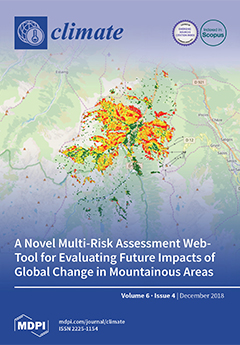Open AccessArticle
Spatio-Temporal Trend Analysis of Rainfall and Temperature Extremes in the Vea Catchment, Ghana
by
Isaac Larbi 1,*, Fabien C. C. Hountondji 2, Thompson Annor 3 , Wilson Agyei Agyare 4, John Mwangi Gathenya 5 and Joshua Amuzu 6
, Wilson Agyei Agyare 4, John Mwangi Gathenya 5 and Joshua Amuzu 6
1
Climate Change and Water Resources, West African Science Service Centre on Climate Change and Adapted Land Use (WASCAL), Universite D’abomey Calavi, 03 BP 526 Cotonou, Benin
2
Faculté d’Agronomie, University of Parakou, Parakou BP 123, Benin
3
Department of Physics, Kwame Nkrumah University of Science and Technology (KNUST), Kumasi, Ghana
4
Department of Agricultural Engineering, Kwame Nkrumah University of Science and Technology, Kumasi, Ghana
5
Soil, Water, and Environmental Engineering Department, Jomo Kenyatta University of Agriculture and Technology (JKUAT), Nairobi 62000, Kenya
6
West African Science Service Center on Climate Change and Adapted Land Use (WASCAL) Headquarters, CSIR Office Complex, Airport Residential Area, P.M.B CT 504, Cantonments-Accra 0233, Ghana
Cited by 52 | Viewed by 8595
Abstract
This study examined the trends in annual rainfall and temperature extremes over the Vea catchment for the period 1985–2016, using quality-controlled stations and a high resolution (5 km) Climate Hazards Group InfraRed Precipitation with Station (CHIRPS) data. The CHIRPS gridded precipitation data’s ability
[...] Read more.
This study examined the trends in annual rainfall and temperature extremes over the Vea catchment for the period 1985–2016, using quality-controlled stations and a high resolution (5 km) Climate Hazards Group InfraRed Precipitation with Station (CHIRPS) data. The CHIRPS gridded precipitation data’s ability in reproducing the climatology of the catchment was evaluated. The extreme rainfall and temperature indices were computed using a RClimdex package by considering seventeen (17) climate change indices from the Expert Team on Climate Change Detection Monitoring Indices (ETCCDMI). Trend detection and quantification in the rainfall (frequency and intensity) and temperature extreme indices were analyzed using the non-parametric Mann–Kendall (MK) test and Sen’s slope estimator. The results show a very high seasonal correlation coefficient (r = 0.99), Nash–Sutcliff efficiency (0.98) and percentage bias (4.4% and −8.1%) between the stations and the gridded data. An investigation of dry and wet years using Standardized Anomaly Index shows 45.5% frequency of drier than normal periods compared to 54.5% wetter than normal periods in the catchment with 1999 and 2003 been extremely wet years while the year 1990 and 2013 were extremely dry. The intensity and magnitude of extreme rainfall indices show a decreasing trend for more than 78% of the rainfall locations while positive trends were observed in the frequency of extreme rainfall indices (R10mm, R20mm, and CDD) with the exception of consecutive wet days (CWD) that shows a decreasing trend. A general warming trend over the catchment was observed through the increase in the annual number of warm days (TX90p), warm nights (TN90p) and warm spells (WSDI). The spatial distribution analysis shows a high frequency and intensity of extremes rainfall indices in the south of the catchment compared to the middle and northern of part of the catchment, while temperature extremes were uniformly distributed over the catchment.
Full article
►▼
Show Figures





